The research group including Professor Kenichi Yamashita, Assistant Professor Shun Takahashi, and others from the Kyoto Institute of Technology Faculty of Electrical Engineering and Electronics succeeded in showing that a polariton state, a hybrid quantum state between light and matter, can be formed using an all-inorganic perovskite. The research group has shown that the use of lead halide perovskite semiconductors is extremely useful for developing the polariton condensed phase at room temperature and with minimal energy injection. The key to this is the peculiarity of the electronically excited states formed in the material.

Drastic transitions of excited state and coupling regime in all-inorganic perovskite microcavities characterized by exciton/plasmon hybrid natures. Yamashita et. al.
https://doi.org/10.1038/s41377-021-00701-8 CC BY 4.0
The group determined that, CsPbBr3, a lead halide perovskite semiconductor comprising all inorganic elements, produces an electron-hole pair correlated by spin at room temperature when photoexcited. This spin-correlated electron-hole pair strongly interacts with a photon confined in the cavity to form a polariton state. The polariton state can form stably even if the density is increased by 10 times, or more, when compared to the polariton state with normal electron-hole pairs due to Coulombic forces. Furthermore, the electron-hole pairs generated in CsPbBr3 had little nucleus binding and could move around relatively freely, compared with organic semiconductors.
This is an important factor for the polariton particles to form a Bose-Einstein condensate, which is a physical phenomenon that falls into a single energy state and behaves cooperatively. Therefore, the formation of the polariton condensed phase by the spin-correlated electron-hole pairs in the CsPbBr3 optical cavity was demonstrated via a special optical experiment. According to Professor Yamashita, "We will develop new optical physics research for quantum devices and optoelectronic device applications using polariton states that can be condensed at room temperature. The polariton state has both light and matter (electron) properties, and when used as a "medium" for information manipulation and transmission, the characteristics of light waves and electrons can be used. We would like to pursue technology that can more easily generate and control such interesting states."
■ Polariton state: By developing an optical microresonator, which is a microstructure that confines light waves with a narrow wavelength using a semiconductor material, the interaction between the electronic state (electron-hole pair) in the semiconductor and the confined light wave (photon) is strengthened, and quasiparticles with hybrid light-matter properties are produced. The generated quasiparticle state is called the "polariton state" and is expected to be the basic physics required to lower the threshold of laser light sources and increase the efficiency of solar cells.
This article has been translated by JST with permission from The Science News Ltd.(https://sci-news.co.jp/). Unauthorized reproduction of the article and photographs is prohibited.




